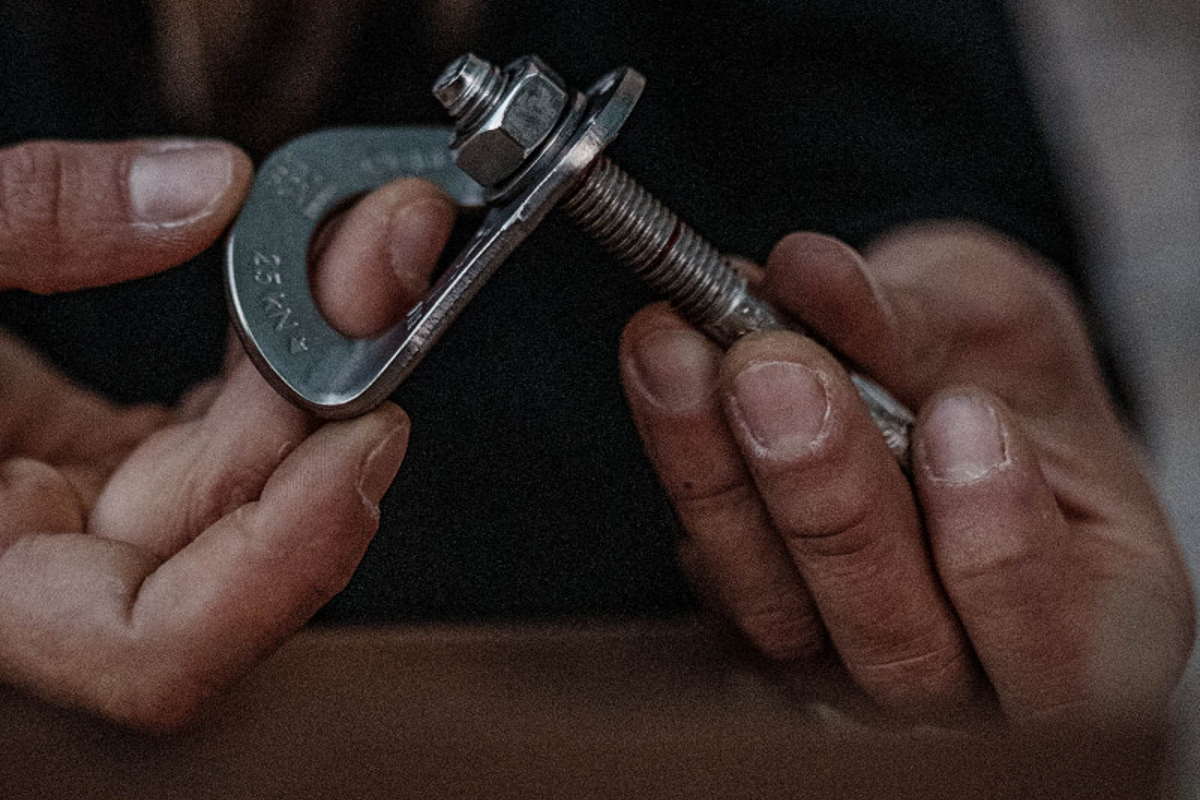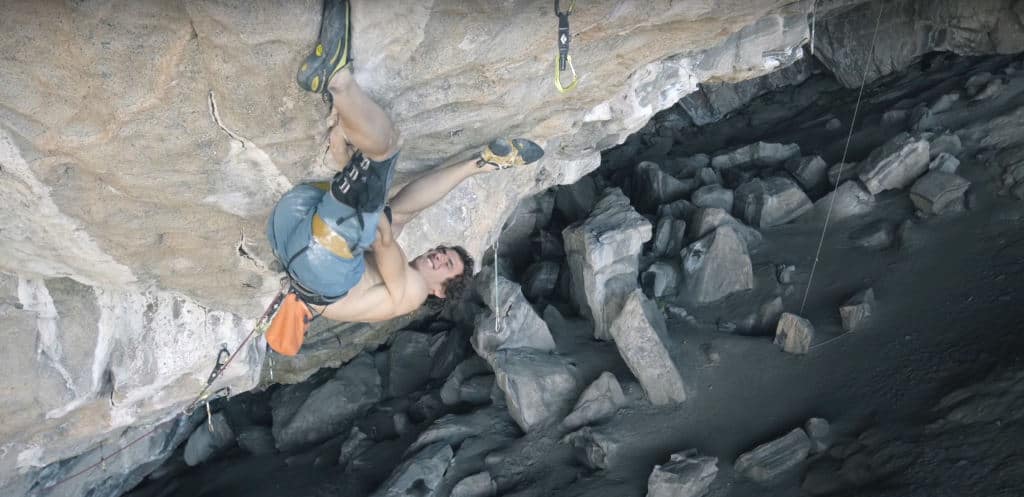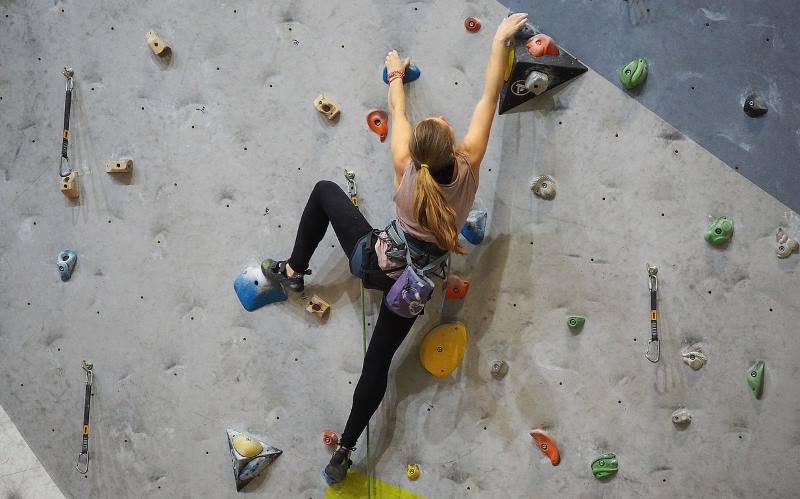Lead Climbing is probably the most popular form of Rock Climbing – now making it’s way to the Olympics for the first time! Indoors and out Lead Climbing will push your limits both physically and mentally, knowing there’s always a chance of a fall.
What Is Lead Climbing?
Lead climbing primarily refers to climbing with a rope and clipping in to fixed protection along the route to protect from a fall. Lead climbing is a form of sport climbing, which is where bolts are drilled into the rock. Climbers have quickdraws attached to their harness, clipping one side to the bolt and the other to the rope.
Lead climbing can be done outdoors or indoors. Indoors the quickdraws are already pre-hung, safety checked, with the bolts are only around a meter apart. Outdoors you place your own quickdraws and the bolts might be two or three meters apart. The bolts might also be old, rusted, or placed incorrectly so you make the ultimate decision on if you trust them
Leading In Trad Climbing
If someone says they are Lead climbing they normally mean Sport climbing. However it can also refer to the “leader” – aka the first person climbing – in Trad climbing. In Trad there aren’t bolts in the wall to clip to so the leader will take protection like cams and nuts with them to place into cracks and seams in the wall.
Most of the time climbers would call that a “Trad lead” with a Sport lead climb just called a “Lead” climb. The person belaying at the bottom is the “second” and is belayed from the top by the leader. The second clears the gear out of the route and the pair rappel down or walk off from the the top.
Lead Climbing At The Olympics
Lead climbing is in the Olympics for the first time ever – as part of the Sport Climbing event at Tokyo in 2021. Lead Climbing, Bouldering, and Speed Climbing are the three categories, with climbers needing to place well in all three for a medal.
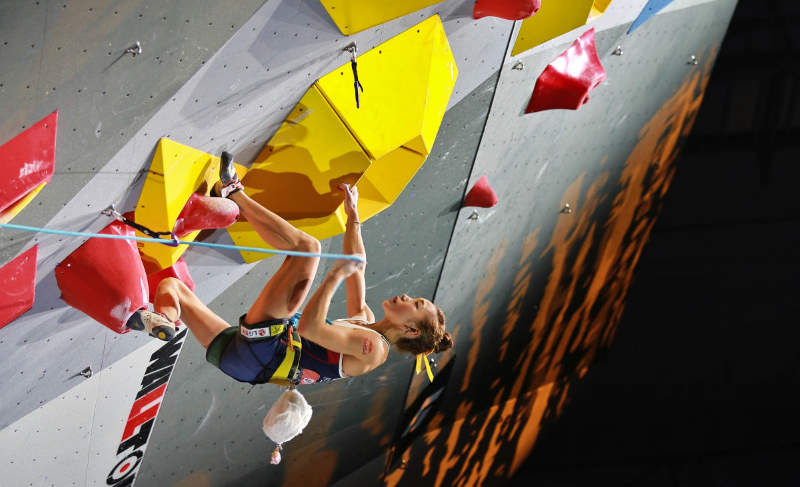
Olympic Lead Climbing Rules
In Lead climbing at the Olympics there are separate routes for the Men’s and Women’s categories. Climbers have one chance to get as far as they can up the wall and clip themselves into every quickdraw along the way. As soon as they leave the floor any fall ends their climb and attempt.
Climbers get a few minutes as a group to observe the route from the ground before being sent to an isolation room. Then one by one each competitor gets one chance to climb as high as possible. They don’t have to use every hold, can use the holds however they like, and can use the wall for their hands or feet – this is called smearing.
They get one point per hold reached – which must be a controlled hold, not just a touch – and to finish the route must also clip the rope into the anchor at the top. If a climber makes an attempt to get the next hold or touches it and then falls the judges will give them a “+” mark.
You’ll see climbers making attempts for a hold when they’re clearly too tired as this + is better than just falling at the last hold. It makes for great viewing and bigger falls! Climbers must clip every single quickdraw and have to fix an incorrect clip in like a “back clip” or “Z-clip”.
Olympic Lead Climbing Wall Height
The Olympic Lead climbing wall in Tokyo is 15 meters or 49 feet high. It’s very overhung and features varied angles and volumes that are attached to add more 3D moves. All of the Sport climbing events are being held together at the Aomi Urban Sports Park which was custom made for the event.
Though the whole event is called Sport Climbing it’s a bit misleading. Lead climbing is a form of Sport climbing but Bouldering and Speed climbing aren’t really – they’re their own thing. In Paris 2024 the three will be split with a set of medals for Speed, then a combined Lead and Boulder category – which will be much better for everyone.
Find Out More
– What Is Bouldering?
– What Is Speed Climbing?
– What Is Sport Climbing?
– Complete Guide To Olympic Climbing
Who Will Win Lead Climbing At The Olympics?
Janja Garnbret is the firm favorite to win Lead at the Olympics. By far she is the best competition Lead climber to the point where it can sometimes seem like she’s on another level from the rest. She’s also poised to win Bouldering, and probably the Gold overall.
There are definitely others who may do well on the day to challenge the crown of Janja. Chaehyun Seo of Korea is a young gun who has previously performed amazingly well in Lead. Laura Rogora is a young Italian climber who is poised to take over both indoor and outdoors. If she is at the top of her game she could well take first.
There are three main favorites to win the Men’s portion of Lead Climbing at Tokyo 2021. First up is Adam Ondra for the Czech Republic who is known as basically the best climber in the world. He was the first person to climb a 9b+ and then a 9c. Though his main passion is for outdoor climbing he’s still a very well decorated competitor.
He’s very much switched modes to focus entirely on getting Gold at the Olympics. If he’s on form he has a very high chance of taking first in Lead and possibly Bouldering as well.
Tomoa Narasaki is Japan’s top hope for Olympic Gold. He gained his place in style by winning the first qualification event – the IFSC Combined Climbing World Championships in 2019 – and continues to show dominance in indoor events. Jakob Schubert is also poised to place in the top 3, if not to outright win in Lead. He’s a veteran competitor who’s shown over and over that he can perform under pressure.
However – winning one event isn’t enough. Climbers have do well in all three events and get a low overall score for a chance at a medal. Their placing in each event is multiplied together for an overall score. The lowest number wins, so a climber with a 1st in Lead, 5th in Speed, and 2nd in Bouldering would get 10 points (1 x 5 x 2 = 10).
Lead Climbing Basics
The basics of Lead climbing are knowing how to clip a quickdraw into a bolt, how to clip the rope into a quickdraw, and how to fall. We really recommend first taking a course at your local gym to learn Leading indoors. Then after some practice hire a guide to take you outdoors.
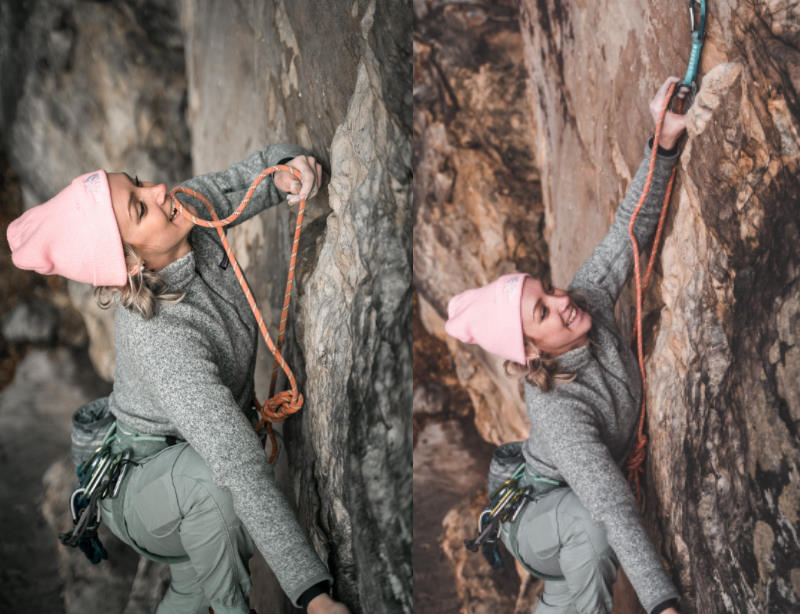
Outdoors you’ll need to know how to re-thread and tie in at the anchor for lowering, as well as assessing the safety of a route and it’s protection. When you get to the top of a Lead route you need to lower off or rappel. Both require you to secure yourself to the top, untie your current knot, thread it through the anchor without dropping it, re-tie, then lower.
You may also need to know how to build a simple anchor using slings and carabiners, clean the anchor, and most importantly some simple bolt and anchor assessment skills. If you don’t feel safe because of dodgy bolts, a nervous belayer, or an old anchor – you don’t have to climb.
Before you jump straight to leading, try reading our full guide on How To Start Rock Climbing today!
How To Lead Climb
Lead climbing is fairly simple to do but can be quite daunting for beginners. Knowing what to do is almost as important as what not to do. Before you start, here are the best Lead Climbing tips we have: –
- Hire an instructor or guide to teach you – Learn it right the first time as mistakes can be fatal. A friend may be experienced but not up to date with modern safety standards.
- You should first be able to comfortably climb most 6a / 5.9 routes onsight, without resting on the rope.
- Start by getting used to Top Roping with some slack in the system, with a few falls to get used to a larger drop.
- Do a few mock leads on routes you have already climbed clean. This is where you are belayed on Top Rope by one person but have another rope tied into your harness to practice clipping – without needing a belayer on the Lead rope.
- After a few repeats on this you should start having someone belay on the Lead rope at the same time. The person belaying Lead is now the primary belayer and Top Rope belayer should give you a safe amount of slack.
- Eventually move to Leading routes you can always climb without a problem. Start easy and get in the mileage and experience of clipping and falling when nervous before pushing the grade.
Lead Climbing Terms
- Quickdraw – Two carabiners linked by a strong, sewn sling. One carabiner clips to the bolt, allowing the sling to dangle freely, with the rope being clipped into the lower carabiner. Outdoors you take your own, indoors they are pre-placed and not removable.
- Carabiner – A metal oval-ish shape that opens with a small gate. Some screw shut but on most quickdraws they snap shut after pushing a rope in. Much stronger than you’d think.
- Bolt – The metal rod that is secured into the wall. Outdoors a hole is drilled first, then the bolt is either an expansion bolt or a glue-in. Indoors they’re secured to T Nuts and sometimes joists behind the wall. Most people use the word “bolt” to refer to the whole setup of bolt, hangar, and nut.
- Hangar – The part you actually clip a quickdraw in to. The protruding piece of metal attached to the wall by the bolt with a nut and washer. Sometimes the hangar is part of the bolt – like with glue-in bolts.
- Anchor / Chains – Where the climber clips in to finish and lower. Normally two bolts with a short chain connecting them, with a ring or carabiner to lower through. “Clipping the chains” is slang from clipping into the anchor, meaning the route is officially done.
- Belay – The belayer is the person on the ground who uses a belay device to feed rope to the climber when needed. The also stop the rope from pulling through when the climber falls – “catching” them. To belay is (to stop) as a verb.
- Clipping – Either clipping a quickdraw into the hangar, or clipping the rope into the quickdraw. Putting the quickdraw and rope in is often called clipping, or the clip i.e. “clipping the second clip”.
- Back Clip – When climbers clip the rope, the rope leading to them should face forwards from the quickdraw/carabiner. If back clipped then a fall can lead the rope to pull down on and open the carabiner!
- Z-Clip – Pulling the rope from under the last quickdraw to clip the next one. The rope looks like a Z and this must be corrected as it isn’t safe.
- Beta – The “moves” or information on how to climb a route – What Is Climbing Beta?
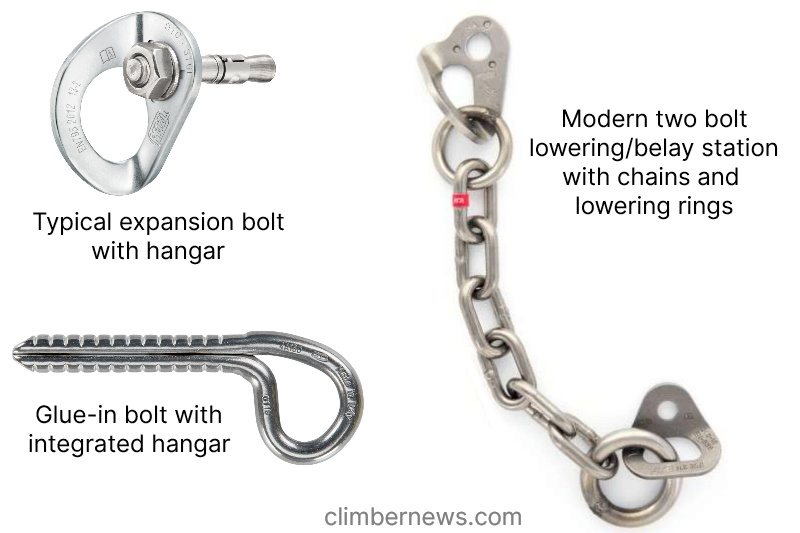
Is Lead Climbing Dangerous? Lead Climbing Falls
Lead climbing isn’t as dangerous as it looks to most who’ve not done it before. For a start, the equipment almost never fails. Climbing ropes are incredibly strong and designed to take repeated falls, even stretching to make the impact softer. The bolts in the walls are designed to be used for years – though outdoors must be placed correctly and checked.
As you fall the rope stretches, which decelerates you slowly. This means less force goes into your body and the gear. A static rope that doesn’t stretch would mean a hard swing into the wall. Belayers often give a “soft catch” by jumping just a little as the climber falls. The climber falls a little further but doesn’t get that hard swing in.
The biggest dangers are from falling onto something below. Often this will be part of the rock face, maybe a tree or shrub on the climb, or a ledge just below. Counter-intuitively a more overhanging climb is safer for falling as there is nothing to fall on to – just empty space.
Other Dangers When Lead Climbing
- Care should be taken on the first 1 to 3 clips as a ground fall is more likely.
- The belayer might “spot” the climber before the first clip by holding their arms up to stop their head hitting the floor/rock if they do fall.
- Clipping a bolt high above the climber can be more dangerous as there is more slack in the rope if they fall before making the clip.
- One side of the quickdraw always goes into the bolt and the other always holds the rope. The metal hangar can leave scratches and sharp burrs in the carabiner that can ruin a rope, the other should be smooth.
- The rope going to the climber should always face outwards from the carabiner on the quickdraw to avoid back clipping.
- Climbers shouldn’t place their leg behind the rope as this can flip them upside down, with their head swinging into the wall
- Climbers should be aware of ledges and other hazards they might fall into on the route
- A fall to the side of a quickdraw can lead to a big swing and scrape against the wall.
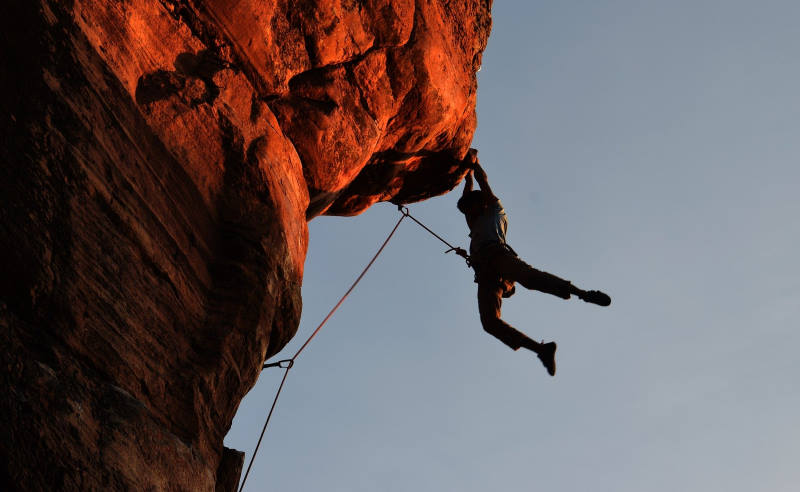
Is Lead Climbing Scary?
Yes, it’s definitely scary taking a fall and even seasoned climbers still get freaked out when they’re high over a bolt and might fall. “Mental game” is big in rock climbing. Knowing that a fall is scary but most likely safe is a disconnect that needs constant work.
How Far Do You Fall When Lead Climbing?
Lead climbing falls can be pretty big, depending on a few things. They’re also part of the game. When people started to climb on bolts (Sport climbing) is when the difficulty of climbs started to jump up. The fact that you could fall over and over safely meant not having to worry about ripping gear out and hitting the floor.
A typical Lead climbing fall might be 2-3 meters or 7-10 feet. Double or even triple that are also fairly common. The higher you are above the last bolt the further the fall. You’ll always fall twice as far as the distance from the knot on your harness to the last bolt, plus: –
- Rope stretch – Can be 10-20%
- Slack rope – Your belayer leaving too much rope slack can add fall distance
- Belayer – The belayer might jump for a soft catch or get pulled up because of a weight difference. If the belayer isn’t paying attention it can mean rope runs through the belay device too.
There are lots of other factors that can add a few inches to a fall but overall it’s more important to know how to fall. That comes with practice. The pros at the Olympics have it drilled in to their head that fear of falling should never enter their thoughts when going for a hard move.
Outdoors Lead climbing falls can be much bigger because of the increased spacing between bolts. Indoors you’ll find a bolt every 1-1.5 meters or 3-5 feet. Outside bolts tend to be further spaced apart for a huge amount of reasons. Older sports climbs from the 70s can often feature just a handful of bolts over a pitch – leading to big runouts and scary falls.
What Is The Difference Between Lead Climbing And Top Roping?
In Top Roping the rope is already secured at the top of the wall. This is either through a bolted anchor in Sport climbing, or by being attached to a rock, tree, or other natural feature, or by using a trad anchor made up of a few pieces of protection placed into the rock.
You don’t fall very far on Top Rope as long as your belayer is paying attention. The rope does stretch so a fall might be a meter / three foot at worst – but it’s a “soft” catch and not a hard swing. Indoors it’s very popular as the rope is already hung, you don’t need to buy your own, and you can practice climbing without big falls.
In Lead climbing you must clip into the wall as you go. Outdoors you need the quickdraws with you which adds time and balance to place them, then to clip the rope in. It’s quite common for one person to Lead a route, then set up a Top Rope for someone else to climb.
It’s generally accepted that Lead climbing is the standard for hard routes and Top Rope is more for practicing a hard route or mileage. That being said, there is nothing wrong with Top Roping and it’s really common for lots of reasons. When you start out you should learn to Top Rope and move on to Lead when comfortable. Many people just Top Rope and don’t worry about the need to try Leading.
Lead Climbing Vs Trad Climbing Differences
The difference between Lead climbing and Trad climbing is about protection. As we said early when we say Lead climbing we mean Sport climbing on Lead, and leading in Trad as just Trad climbing. In Lead climbing (Sport) you clip Quickdraws into hangars that are bolted into the rock. On a Trad climbing lead you place your own protection into gaps and cracks in the world.
| Lead Climbing (Sport Climbing) | Trad Climbing | |
| Protection | Bolts drilled or glued into wall | Various pieces placed into a wall |
| Gear | Quickdraws | Cams, nuts, tricams, beaks, slings |
| Started | Late 70’s / Early 80’s | ~1880’s, modern gear started developing throughout the 1900’s |
| Safety | Fairly safe, falls are generally small and gear rarely fails | Falls can pull gear from wall and lead to larger falls or hitting the floor |
| Pros | Easy to start, lots of climbing in a day, focuses on physical and technical improvement | Basically no limit to where or what you can climb, can do huge walls and big adventurous days out |
| Cons | Limited to bolted areas and generally single pitch (30-40 meters) only | Gear is expensive and it takes a long time to learn and push grades. Harder climbs are generally more dangerous |
How To Start Lead Climbing
We suggest you try learning to Top Rope first, then switch to Lead climbing. Top roping allows you to build up basic climbing skills and technique as well as rope handling skills. It also gives you the confidence to push yourself without taking big falls or possibly getting into dangerous situations.
First off a taster session at your local climbing gym is a great idea, followed by a couple of Intro classes to teach you top roping skills. After a few months of regular climbing that’s the time to take a Learn to Lead course. After that, an outdoor day with experienced friends or a local guide will show you what real rock climbing has to offer!
What Equipment Do You Need To Lead Climb?
Lead climbing is comparatively cheap to get into compared to Trad. The big things you’ll need to start Lead climbing indoors are a harness, shoes, belay device and carabiner, your own rope, plus a chalk bag and chalk. You can get all this for around $250-300.
To Lead climb outdoors you’ll also need a helmet, personal anchor system, and your own set of 12-14 quickdraws. This will add another $200-300 to the total. This gear will last you years apart from the shoes which you will need to replace or resole after maybe a year as a beginner.
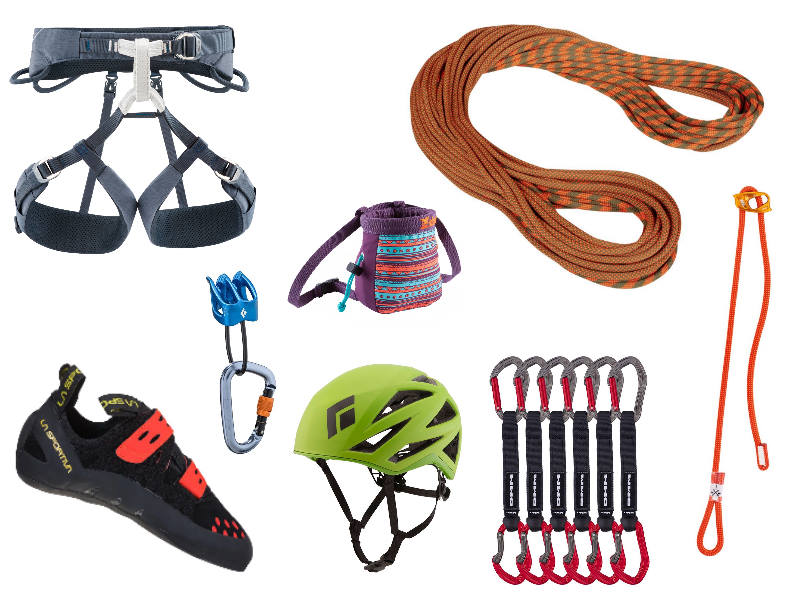
On top of this you could get a clip stick, a rope bag or good climbing backpack, and some handy belay specs. Check out our recommendations for the best beginner gear below.
– Best Beginner Climbing Shoes
– Best Beginner Climbing Rope
– Best Beginner Climbing Harness
– Best Beginner Belay Device + Belay Carabiner
– Best Climbing Helmet
Is Lead Climbing Free Climbing?
Yes, Lead climbing is a form of Free climbing. Free climbing refers to climbing a rock face under your own power but using a rope and harness for safety. Lead climbing, Top Roping, and Trad climbing are all forms of free climbing. Free Soloing is where a person climbs without a rope.
Confused?
– What Is Free Climbing?
– What Is Free Soloing + Famous Soloists
Lead Climbing Certification
In many gyms in the USA there is an in house certification for Top Roping, then a separate one for Lead climbing. You will have to pass a short test that shows you can belay safely, know your gear, and are generally competent and confident with what you are doing: –
- Put your harness on correctly with the waist and leg loops correctly oriented, without a twisted belay loop. Harness should be tightened right for your body/harness.
- Tie in using a knot and a stopper, using the two tie-in points. This is normally always the re-threaded figure of eight, and a barrel knot for a stopper. The knot should be close to you, the stopper close on top, without a long tail or loop.
- Can check climbers harness or belay device set up.
- Set up the belay device correctly. Belay safely, never taking a closed fist off of the brake rope. Give enough slack for clipping, take in when needed.
- Catch a fall safely. You may need to do a “soft catch” with a little hop or move into the wall.
- Lower safely and in control.
Once you pass you can climb in that gym (it doesn’t transfer to others) and normally have to wear a little dangly card on your harness so staff know you are safe to belay.
